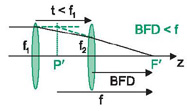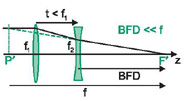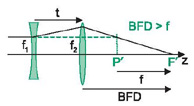Optipedia • SPIE Press books opened for your reference.
Objectives
Excerpt from Field Guide to Geometrical Optics

Objectives are lens element combinations used to image (usually) distant objects. To classify the objective, separated groups of lens elements are modeled as thin lenses. The simple objective is represented by a positive thin lens.
Simple Objective
Petzval Objective

The Petzval objective consists of two separated positive groups of elements. The system rear principal plane is located between the groups.
Telephoto Objective

The telephoto objective produces a system focal length longer than the overall system length (t + BFD). It consists of a positive group followed by a negative group.
Reverse Telephoto Objective

The reverse telephoto objective or retrofocus objective consists of a negative group followed by a positive group. This configuration is used to produce a system with a BFD larger than the system focal length. While this configuration is used for many wide angle objectives, the term reverse telephoto specifically refers to the configuration, not the FOV.
A collimator is a reversed objective. It creates a collimated beam from a source at the system front focal point, and the image of the source is projected to infinity. The degree of collimation is determined by the source size.
J. E. Greivenkamp, Field Guide to Geometrical Optics, SPIE Press, Bellingham, WA (2004).
View SPIE terms of use.

